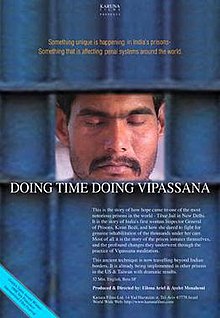| Doing Time, Doing Vipassana | |
|---|---|
 theatrical poster | |
| Directed by | |
| Produced by | Eilona Ariel |
| Starring | Kiran Bedi |
| Narrated by | Paul Samson |
| Cinematography | Ayelet Menahemi |
| Edited by | Ayelet Menahemi |
| Music by |
|
Production company | Karuna Films |
| Distributed by | Immediate Pictures (2005 theatrical) |
Release date | 1997 |
Running time | 52 minutes |
| Countries |
|
| Language | English |
Doing Time, Doing Vipassana is a 1997 Israeli independent documentary film project by two women filmmakers from Israel: Ayelet Menahemi and Eilona Ariel. The film is about the application of the vipassana meditation technique taught by S. N. Goenka to prisoner rehabilitation at Tihar Jail in India [1] (which was reputed to be an exceptionally harsh prison). [2] The film inspired other correctional facilities such as the North Rehabilitation Facility in Seattle to use Vipassana as a means of rehabilitation. [3]
Kiran Bedi, former Inspector General of Prisons for New Delhi, appears in the film.
Reception
Doing Time, Doing Vipassana received an average score of 64 based on eight critics at Metacritic. [4] It received a 71% rating based on 14 reviews at Rotten Tomatoes. [5]
The San Francisco Chronicle wrote of the film winning the Golden Spire Award at the San Francisco International Film Festival when noting its 2005 theatrical release. They praised the film, writing it had "distinct virtues: It tells a fascinating story. It makes a strong case for an alternative approach to incarcerated criminals. And it provides an attractive introduction to Vipassana meditation." [6]
Slant Magazine gave the film two out of five stars, and generally panned the film, stating that the directors "fail to really get inside the heads of their subjects and to seriously convey the extent to which violence plays a role in their daily lives, choosing instead to follow the process with which Vipassana comes to the prison community and holds its prisoners in rapture." They felt the film's repeated use of "hyperbolic narration....strains to summon a sense of spiritual gravitas" and that the filmmakers brevity and informational tone made the film "something akin to an Epcot Center attraction." [7]
Awards and nominations
- 1998, winner of 'Golden Spire Award' at the San Francisco International Film Festival [6] [8]
- 1998, winner of NCCD Pass Award from the American National Council on Crime and Delinquency [9]
- 2000, winner of 'Gold Illumination Award' at Crested Butte Film Festival
- 2000, winner of 'Silver Award' for best documentary at Crested Butte Reel Fest
See also
References
- ^ Holden, Stephen (8 July 2005). "Prisoners Finding New Hope in the Art of Spiritual Bliss". The New York Times. Retrieved 29 September 2013.
- ^ King, Sallie B. (2009). Socially Engaged Buddhism. University of Hawaii Press. p. 152. ISBN 978-0824833350.
- ^ Zook, Kristal Brent (2006). Black women's lives : stories of power and pain. New York: Nation Books. pp. 239–240. ISBN 1560257903.
- ^ "Doing Time, Doing Vipassana". Metacritic. Retrieved 30 September 2013.
- ^ "Doing Time, Doing Vipassana (1997)". Rotten Tomatoes. Retrieved 30 September 2013.
- ^ a b LaSalle, Mick (27 May 2005). "Also opening Friday". San Francisco Chronicle. Retrieved 29 September 2013.
- ^ Gonzales, Ed (6 July 2005). "review: Doing Time, Doing Vipassana". Slant Magazine. Retrieved 30 September 2013.
- ^ Its Always Possible: Transforming One of the Largest Prisons in the World. Sterling Publishers Pvt. Ltd. 2005. p. 307. ISBN 8120728866.
- ^ staff (24 March 1999). "Award-winning video to be presented". Juneau Empire. Archived from the original on 4 March 2016. Retrieved 29 September 2013.